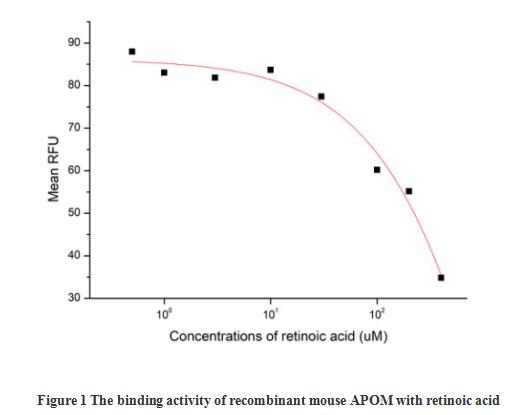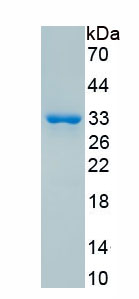Active Apolipoprotein M (APOM) 

Apo-M; G3a; NG20; Protein G3a
Overview
Properties
- Product No.APC299Mu01
- Organism SpeciesMus musculus (Mouse) Same name, Different species.
- ApplicationsCell culture; Activity Assays.
Research use only - DownloadInstruction Manual
- CategoryMetabolic pathwayCardiovascular biologyHepatologyNutrition metabolism
- Buffer FormulationPBS, pH7.4, containing 0.01% SKL, 5% Trehalose.
- Traits Freeze-dried powder, Purity > 95%
- Isoelectric Point5.9
Sign into your account
Share a new citation as an author
Upload your experimental result
Review

Contact us
Please fill in the blank.
Activity test

Apolipoprotein M (APOM) is an approximately 25 kDa variably glycosylated protein that adopts a beta-barrel structure characteristic of lipocalin family proteins. It functions as a component of lipoprotein particles which play essential roles in fatty acid and cholesterol transport and metabolism. Alternative splicing generates a short isoform that lacks the N-terminal 72 amino acids. APOM is produced primarily by hepatocytes but also by renal tubule epithelial cells. The signal peptide is not cleaved and is required for APOM association with lipoprotein particles as well as Megalin mediated reabsorption by the kidney. The activity of recombinant mouse APOM was measured by its ability to bind all-trans retinoic acid. The binding of retinoic acid results in the quenching of Trp fluorescence in APOM. APOM was diluted to 50 ug/ml in 50 mM Tris, 10 mM CaCl2, 150 mM NaCl, pH 7.5 (assay buffer) and the retinoic acid was diluted to 400, 200, 100, 30, 10, 3, 1 and 0.5 µM in 95% ethanol. Mixing 112.5 µL of 50 µg/mL rmAPOM and 12.5 µL of retinoic acid serial dilutions in microtubes and a blank containing 112.5 µL of 50 µg/mL rmAPOM and 12.5 µL of 95% ethanol, then incubate at room temperature for 30 minutes. Loading 100 ul of the reaction mixtures and blank and read at excitation and emission wavelengths of 280 nm and 340 nm (top read), respectively, in endpoint mode. The result was shown in figure 1, the 50% binding concentration (BC50) is >300 µM.
Usage
Reconstitute in 10mM PBS (pH7.4) to a concentration of 0.1-1.0 mg/mL. Do not vortex.
Storage
Avoid repeated freeze/thaw cycles. Store at 2-8°C for one month. Aliquot and store at -80°C for 12 months.
Stability
The thermal stability is described by the loss rate. The loss rate was determined by accelerated thermal degradation test, that is, incubate the protein at 37°C for 48h, and no obvious degradation and precipitation were observed. The loss rate is less than 5% within the expiration date under appropriate storage condition.
Increment services
-
 BCA Protein Quantification Kit
BCA Protein Quantification Kit
-
 Molecular Mass Marker for Protein
Molecular Mass Marker for Protein
-
 Monoclonal Antibody Customized Service
Monoclonal Antibody Customized Service
-
 Polyclonal Antibody Customized Service
Polyclonal Antibody Customized Service
-
 Protein Activity Test Experiment Service
Protein Activity Test Experiment Service
-
 Electrophoretic Mobility Shift Assay (EMSA) Experiment Service
Electrophoretic Mobility Shift Assay (EMSA) Experiment Service
-
 Buffer
Buffer
-
 Lentivirus Packaging Experiment Service
Lentivirus Packaging Experiment Service
-
 Adenovirus Packaging Experiment Service
Adenovirus Packaging Experiment Service
-
 Real Time PCR Experimental Service
Real Time PCR Experimental Service
-
 Spike RBD Protein (S-RBD)
Spike RBD Protein (S-RBD)
-
 Protein G
Protein G
-
 Protein A
Protein A
Citations
- Apolipoprotein m (APOM) levels and APOM rs805297 G/T polymorphism are associated with increased risk ofrheumatoid arthritisPubmed: 23660425
- The miR-573/apoM/Bcl2A1-dependent signal transduction pathway is essential for hepatocyte apoptosis and hepatocarcinogenesisPubMed: 26201458
- Effects of hyperlipidaemia on plasma apolipoprotein M levels in patients with type 2 diabetes mellitus: an independent case–control studypubmed:27633510
- A single-nucleotide polymorphism C-724 /del in the proter region of the apolipoprotein M gene is associated with type 2 diabetes mellituspubmed:27576735
- ApoM/HDL-C and apoM/apoA-I ratios are indicators of diabetic nephropathy in healthy controls and type 2 diabetes mellitus.pubmed:28073663
- Level of serum apolipoprotein m and its diagnostic significance in inflammatory bowel diseasefiles:ijcep0033416.pdf
- Endurance training selectively increases HDL-bound sphingosine-1-phosphate in the plasma pubmed:28493600
- HDL-S1P Protects Endothelial Function and Reduces Lung Injury During Sepsis in vivo and in vitroPubmed: 32750426
- Biomechanical Properties of Blood Plasma Extracellular Vesicles Revealed by Atomic Force Microscopy33374530
- Apolipoprotein M in High Density Lipoprotein Protects Against Astrocyte Apoptosis Induced By Ischemic Insult Via Sphingosine 1-Phosphate Signaling







